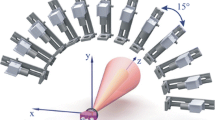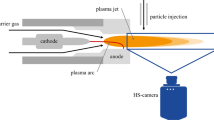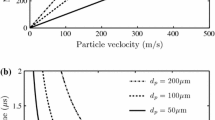Abstract
Diagnostic methods using a tomographic reconstruction allow for three-dimensional characterization of spraying processes. Since in many spraying applications, non-rotationally symmetric phenomena occur, the application of emission tomography methods seems most reasonable. Yet, to be able to apply this method the observed object has to be luminous and optically thin. Hence, to investigate a particle stream, the optical thickness of such a stream has to be estimated beforehand. Within this paper, a method to determine this parameter, based on particle rate, size and velocity measurements is presented and applied to a wire arc spray process, proving that it is possible to perform a tomographic investigation of a particle beam.









Similar content being viewed by others
References
C. Baukal, Industrial Combustion Testing, 1st ed., CRC Press, Boca Raton, 2010
P. Lehmann, In-Process Laser-Messmethoden auf der Grundlage der Fourieranalyse, expert-Verlag, Berlin, 2003
T. Streibl, T. Duda, K. Landes, Diagnostics of thermal spray processes by in-flight measurement of particle size and shape with innovative particle-shape-imaging (PSI) technique, in Proceedings of SPIE 4308, High-Speed Imaging and Sequence Analysis III, 2001
M.-M. Matz and M. Aumiller, Practical comparison of cylindrical nozzle and de Laval nozzle for wire arc spraying, J. Therm. Spray Technol., 2014, 23(8), p 1470-1477
E. Hämäläinen et al., in Imaging Diagnostics in Thermal Spraying-Spraywatch System, Thermal Spray: Surface Engineering via Applied Research, ed. by C.C. Berndt (ASM International, Montréal, Québec, Canada), 8–11 May 2000, p. 1383
K. Landes, Diagnostics in plasma spraying techniques, Surf. Coat. Technol., 2006, 201(5), p 1948-1954
J. Zierhut, K. D. Landes, W. Kroemmer, P. Heinrich, in Particle Flux Imaging (PFI) In Situ Diagnostics for Thermal Coating Process, Thermal Spray: Surface Engineering via Applied Research, ed. by C.C. Berndt (ASM International, Montréal, Québec, Canada), 8–11 May 2000, p. 1383
J. Schein et al., Tomographic investigation of plasma jets produced by multielectrode plasma torches, J. Therm. Spray Technol., 2008, 17(3), p 338-343
J. Hlína and J. Šonský, Time-resolved tomographic measurements of temperatures in a thermal plasma jet, J. Phys. D Appl. Phys., 2010, 43(5), p 55202
A. Fridman, Plasma Chemistry, Cambridge University Press, Cambridge, 2008
A. Fridman and L. Kennedy, Plasma Physics and Engineering, Taylor & Francis, Abingdon, 2004
S. Ozcelik, K. Moore, and D. Naidu, Modeling sensing and control of gas metal arc welding, Elsevier, Amsterdam, 2003
F. Durst, A. Melling, and J.H. Whitelaw, Principles and practice of laser-Doppler anemometry, Academic Press, New York, 1976
C. Tropea, A. Yarin, and J. Foss, Springer Handbook of Experimental Fluid Mechanics, Springer, Berlin, 2007
G. Mauer et al., Investigation and comparison of in-flight particle velocity during the plasma-spray process as measured by laser Doppler anemometry and DPV-2000, J. Therm. Spray Technol., 2013, 22(6), p 892-900
M. Krauss et al., In-situ particle temperature, velocity and size measurements in the spray forming process, Mater. Sci. Eng. A, 2002, 326(1), p 154-164
G. Mauer, R. Vaßen, and D. Stöver, Comparison and applications of DPV-2000 and accuraspray-g3 diagnostic systems, J. Therm. Spray Technol., 2007, 16(3), p 414-424
C. Moreau et al., Diagnostics for advanced materials processing by plasma spraying, Pure Appl. Chem., 2005, 77(2), p 443-462
Tecnar Automation Ltd, DPV Evolution: Product Manual, Edition 1, 2012
S. Zimmermann, K. Landes, and J. Schein, Innovative particle characterization method for thermal spray processes, Materialwiss. Werkstofftech., 2008, 39(1), p 18-23
Author information
Authors and Affiliations
Corresponding author
Additional information
Publisher's Note
Springer Nature remains neutral with regard to jurisdictional claims in published maps and institutional affiliations.
Rights and permissions
About this article
Cite this article
Szulc, M., Kirner, S., Bredack, M. et al. A Method to Estimate the Optical Thickness of an Opaque Stream of Particles Based on Particle Rate, Size and Velocity Measurements as A Necessity to Enable Tomographic Analysis. J Therm Spray Tech 28, 1627–1635 (2019). https://doi.org/10.1007/s11666-019-00910-z
Received:
Revised:
Published:
Issue Date:
DOI: https://doi.org/10.1007/s11666-019-00910-z




